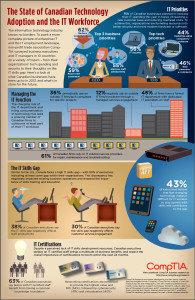Although there can be countless adoption gaps found throughout your company’s various department, it is most evident whenever technology is involved.
You might not realize, but each employee (including yourself) interacts with an average of 10 different technologies every day and are subjected to 30+ company changes every year. This gets overwhelming and fosters resistance to change, if not taken care of properly.
 In 2013, CompTIA released an Infographic about the State of Technology and the IT workforce. Although it focuses on the Canada as a location, this is a global concern that is only expected to grow in the future.
In 2013, CompTIA released an Infographic about the State of Technology and the IT workforce. Although it focuses on the Canada as a location, this is a global concern that is only expected to grow in the future.
Here are the key points:
- 75% of businesses plan to increase IT spending in hopes of reaching new customers and reducing costs.
- 55% of CEO’s state “improving staff productivity” as a top business priority.
- 44% of CIO’s state “updating aging computers/software as a top tech priority.
- 90% of executives confirm that there is at least some indication of an IT skills gap within their organization.
- 38% of executives connect the IT skills gap with poor employee productivity.
- 30% of executives connect the IT skills gap with poor customer service/engagement.
- 43% of executives believe that fast changing technology makes it difficult for workers to stay current on the skills required to reduce the skills gap.
How do you bridge the gap?
Most executives will make training programs a priority, but does it work?
It can for some cases. For instance, if you’re implementing a new information security or network solution, providing them with in-class training would certainly increase the general knowledge and understanding of the solution. But that’s as far as it goes, and the learning won’t last long… in fact, they’re likely to forget 80% of what was taught in the class 14 days later.
Additionally, traditional training can be highly inefficient for both cost and resources.
- Resources. Depending on the expected outcomes of the training investment, employees could be out of commission for 1-3 days. This means that not only will there be a gap in resources within the company, but the employees will be stressed to catch up when they return to work.
- Cost. Think about the last time you changed to a new phone system or there was a simple software update, this change affected almost your entire company. It would be virtually irresponsible to send all your employees to in-class training for these changes.
Some companies try to accommodate by given their employees access to LMS servers that host documents and manuals on how to perform certain tasks. Although this is a step in the right direction, it’s too frustrating and difficult for your employees to find exactly what they need to know when they need to know it, so they’ll continue to not learn the system.
Instead… do this:
When sending your employees to traditional training, be sure that they receive follow-up activities that reinforce the information learned during the training program.
If you’re looking to reduce cost, train a large number of employees, and/or simplify the onboarding process, you best bet would be to create short videos that are 5 minutes long. The first trick is to focus on the “need to know” and essential information that the employees would need to know to either work the technology, or increase proficiency and add to their current knowledge. The second trick is to make sure that your employees complete periodic activities to reinforce the learning from the videos. The third trick is to monitor who views the video and completes the activities.
If you do this properly, the investment in the platform will pay off ten-fold. Not only will your employees become more engaged in the changes that you implement, they will become more proficient and efficient workers. This reduces costs and increases productivity.

